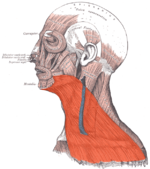- Platysma
-
Platysma (gr. πλάτυσμα „Platte“) ist die anatomische Bezeichnung für einen Hautmuskel (Musculus cutaneus) des Halses. Der Muskel liegt zwischen Haut und der oberflächlichen Halsfaszie, hat also keinen direkten Kontakt zum Skelett. Er kann der mimischen Muskulatur zugeordnet werden.
Mensch
Beim Menschen entspringt das Platysma im Bereich von Kinn und Wangen und zieht zum oberen Thorax.
Es ist bei Schreckreaktionen oder einer angespannten Mimik aktiv, er wölbt die Haut vor und kann den Unterkiefer oder manchmal auch den Mundwinkel nach unten ziehen. Nur wenige Menschen vermögen aber, ihn bewusst einzusetzen. Bei alten Menschen mit erschlaffter Haut wird der Medialrand (zur Mitte gelegene) des Platysmas beider Seiten als Längsfalten im vorderen Halsbereich sichtbar. Innerviert wird das Platysma durch den Nervus facialis.
Halshautmuskeln der Haustiere
Bei den Haustieren kommt ein Platysma nur bei Raubtieren (Hund, Katze) und bei Schweinen vor. Hier endet es nicht am Thorax, sondern zieht nach hinten-oben zur Nackenlinie.
Bei Fleischfressern wird es durch zwei zusätzliche Halshautmuskeln komplettiert. Der Musculus sphincter colli superficialis besteht aus querverlaufenden Muskelfasern, und erstreckt sich auf das gesamte Gebiet zwischen Unterkiefer und Brust. Der Muskel dient der Straffung der Haut an der Halsunterseite. Der Musculus sphincter colli profundus der Raubtiere liegt unter dem Platysma im Gebiet der Ohrspeicheldrüse (Regio parotidea).
Bei Huftieren ist kein Platysma ausgebildet. Ein Hautmuskel ist bei ihnen nur im hinteren Halsbereich ausgebildet und wird als Musculus cutaneus colli bezeichnet. Er besteht aus schräg verlaufenden Muskelfasern, die den hinteren Teil der Drosselrinne überdecken.
Literatur
- Franz-Viktor Salomon: Muskelgewebe. In: Anatomie für die Tiermedizin. Enke Stuttgart, 2004, S. 147–234. ISBN 3-8304-1007-7
Kategorien:- Quergestreifte Muskulatur
- Anatomie der Haut
Wikimedia Foundation.

